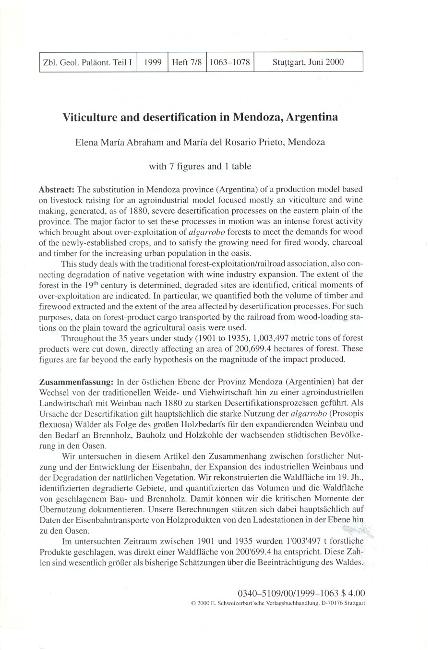Mostrar el registro sencillo del ítem
dc.contributor.author
Abraham, Elena Maria

dc.contributor.author
Prieto, Maria del Rosario

dc.date.available
2022-02-18T03:10:48Z
dc.date.issued
2000-02
dc.identifier.citation
Abraham, Elena Maria; Prieto, Maria del Rosario; Viticulture and desertification in Mendoza, Argentine; E. Schweizerbart Science; Zentralblatt für Geologie und Paläontologie; 7/8; 2-2000; 1063-1078
dc.identifier.issn
0340-5109
dc.identifier.uri
http://hdl.handle.net/11336/152259
dc.description.abstract
The substitution in Mendoza province (Argentina) of a production model based on livestock raising for an agroindustrial model focused mostly an viticulture and wine making, generated, as of 1880, severe desertification processes on the eastem plain of the province. The major factor to set these processes in motion was an intense forest activity which brought about over-exploitation of algarrobo forests to meet the demands for wood of the newly-established crops, and to satisfy the growing need for fired woody, charcoal and timber for the increasing urban population in the oasis. This study deals with the traditional forest-exploitationlrailroad association, also connecting degradation of native vegetation with wine industry expansion. The extent of the forest in the 19thcentury is determined, degraded sites are identified, critical moments of over-exploitation are indicated. In particular, we quantified both the volume of timber and firewood extracted and the extent of the area affected by desertification processes. For such purposes, data on forest-product cargo transported by the railroad from wood-Ioading stations on the plain toward the agricultural oasis were used. Throughout the 35 years under study (1901 to 1935), 1,003,497 metric tons of forest products were cut down, directly affecting an area of 200,699.4 hectares of forest. These figures are far beyond the early hypothesis on the magnitude of the impact produced.
dc.description.abstract
In der ostlichen Ebene der Provinz Mendoza (Argentinien) hat der Wechsel von der traditionellen Weide- und Viehwirtschaft hin zu einer agroindustriellen Landwirtschaft mit Weinbau nach 1880 zu starken Desertifikationsprozessen geführt. Als Ursache der Desertifikation gilt hauptsiichlich die starke Nutzung der algarrobo (Prosopis flexuosa) Wiilder als Folge des groBenHolzbedarfs für den expandierenden Weinbau und den Bedarf an Brennholz, Bauholz und Holzkohle der wachsenden stiidtischen BevOlkerung in den Oasen. Wir untersuchen in diesem Artikel den Zusammenhang zwischen forstlicher Nutzung und der Entwicklung der Eisenbahn, der Expansion des industriellen Weinbaus und der Degradation der natürlichen Vegetation.Wir rekonstruierten die Waldfliicheim 19.Jh., identifizierten degradierte Gebiete, und quantifizierten das Volumen und die Waldfliiche von geschlagenem Bau- und Brennholz. Damit konnen wir die kritischen Momente der Übemutzung dokumentieren. Unsere Berechnungen stützen sich dabei hauptsiichlich auf Daten der Eisenbahntransporte von Holzprodukten von den Ladestationen in der Ebene hin zu den Oasen. 1m untersuchten Zeitraum zwischen 1901 und 1935 wurden 1'003'497 t forstliche Produkte geschlagen, was direkt einer Waldfliiche von 200'699.4 ha entspricht. Diese Zahlen sind wesentlich groBerals bisherige Schiitzungenüber dieBeeintriichtigungdes Waldes.
dc.description.abstract
La sustitución en Mendoza de un modelo productivo basado en la ganadería comercial por uno agroindustrial centrado en la vitivinicultura a partir de 1880, generó fuertes procesos de desertificación en la llanura oriental de la provincia. El principal agente de esos procesos fue la actividad forestal que produje la sobreexplotación de los bosques de algarrobo para responder a la demanda de madera de las nuevas explotaciones agrícolas y del creciente uso de leña y carbón de la creciente población urbana en el oasis. Este trabajo avanza sobre la tradicional asociación del bosque y el ferrocarril, relacionando también la degradación de la vegetación de la llanura mendocina con la expansión de la industria vitivinícola. Se determina la extensión del bosque durante el siglo XIX, se identifican los sitios degradados, se señalan los momentos críticos de la sobreexplotación y en especial se cuantifica la cantidad de madera y leña extraídas y la superficie afectada por los procesos de desertificación generados. Para ello se utilizaron los datos de las cargas de productos forestales que transportaba el ferrocarril (BAP) desde las estaciones de la llanura hasta el oasis agrícola. En los 35 años estudiados (1901-1935) se talaron 1.003.497 Tn de productos forestales que afectaron directamente una superficie de 200.699,4 Ha de bosque talado. Estas cifras superaron las hipótesis iniciales sobre la importancia del impacto producido.
dc.format
application/pdf
dc.language.iso
eng
dc.publisher
E. Schweizerbart Science
dc.rights
info:eu-repo/semantics/openAccess
dc.rights.uri
https://creativecommons.org/licenses/by-nc-sa/2.5/ar/
dc.subject
VITIVINICULTURA
dc.subject
PROCESOS DE DESERTIFICACION
dc.subject
MENDOZA, ARGENTINA
dc.subject.classification
Ciencias Medioambientales

dc.subject.classification
Ciencias de la Tierra y relacionadas con el Medio Ambiente

dc.subject.classification
CIENCIAS NATURALES Y EXACTAS

dc.title
Viticulture and desertification in Mendoza, Argentine
dc.type
info:eu-repo/semantics/article
dc.type
info:ar-repo/semantics/artículo
dc.type
info:eu-repo/semantics/publishedVersion
dc.date.updated
2021-02-18T15:22:05Z
dc.journal.number
7/8
dc.journal.pagination
1063-1078
dc.journal.ciudad
Stuttgart
dc.description.fil
Fil: Abraham, Elena Maria. Consejo Nacional de Investigaciones Científicas y Técnicas; Argentina
dc.description.fil
Fil: Prieto, Maria del Rosario. Consejo Nacional de Investigaciones Científicas y Técnicas; Argentina
dc.journal.title
Zentralblatt für Geologie und Paläontologie
Archivos asociados
